SNAS676D October 2015 – October 2017 LMK61A2-100M , LMK61A2-125M , LMK61A2-156M , LMK61A2-312M , LMK61A2-644M , LMK61E0-050M , LMK61E0-155M , LMK61E0-156M , LMK61E2-100M , LMK61E2-125M , LMK61E2-156M , LMK61E2-312M , LMK61I2-100M
PRODUCTION DATA.
- 1 Features
- 2 Applications
- 3 Description
- 4 Revision History
- 5 Pin Configuration and Functions
-
6 Specifications
- 6.1 Absolute Maximum Ratings
- 6.2 ESD Ratings
- 6.3 Recommended Operating Conditions
- 6.4 Thermal Information
- 6.5 Electrical Characteristics - Power Supply
- 6.6 LVPECL Output Characteristics
- 6.7 LVDS Output Characteristics
- 6.8 HCSL Output Characteristics
- 6.9 OE Input Characteristics
- 6.10 Frequency Tolerance Characteristics
- 6.11 Power-On/Reset Characteristics (VDD)
- 6.12 PSRR Characteristics
- 6.13 PLL Clock Output Jitter Characteristics
- 6.14 Typical 156.25-MHz Output Phase Noise Characteristics
- 6.15 Additional Reliability and Qualification
- 6.16 Typical Characteristics
- 7 Parameter Measurement Information
- 8 Power Supply Recommendations
- 9 Layout
- 10Device and Documentation Support
- 11Mechanical, Packaging, and Orderable Information
Package Options
Refer to the PDF data sheet for device specific package drawings
Mechanical Data (Package|Pins)
- SIA|6
Thermal pad, mechanical data (Package|Pins)
Orderable Information
9 Layout
9.1 Layout Guidelines
The following sections provides recommendations for board layout, solder reflow profile and power supply bypassing when using LMK61XX to ensure good thermal / electrical performance and overall signal integrity of entire system.
9.1.1 Ensuring Thermal Reliability
The LMK61XX is a high performance device. Therefore, pay careful attention to device configuration and printed-circuit board (PCB) layout with respect to power consumption. The ground pin needs to be connected to the ground plane of the PCB through three vias or more, as shown in Figure 18, to maximize thermal dissipation out of the package.
Equation 1 describes the relationship between the PCB temperature around the LMK61XX and its junction temperature.
where
- TB: PCB temperature around the LMK61XX
- TJ: Junction temperature of LMK61XX
- ΨJB: Junction-to-board thermal resistance parameter of LMK61XX (37.7°C/W without airflow)
- P: On-chip power dissipation of LMK61XX
To ensure that the maximum junction temperature of LMK61X2 is below 125°C, the maximum PCB temperature without airflow should be at 99°C or below (89°C or below for LMK61X0) when the device is optimized for best performance resulting in maximum on-chip power dissipation of 0.68 W.
9.1.2 Best Practices for Signal Integrity
For best electrical performance and signal integrity of entire system with LMK61XX, TI recommends routing vias into decoupling capacitors and then into the LMK61XX. TI also recommends increasing the via count and width of the traces wherever possible. These steps ensure lowest impedance and shortest path for high frequency current flow. Figure 18 shows the layout recommendation for LMK61XX.
 Figure 18. LMK61XX Layout Recommendation for Power Supply and Ground
Figure 18. LMK61XX Layout Recommendation for Power Supply and Ground
9.1.3 Recommended Solder Reflow Profile
TI recommends following the solder paste supplier's recommendations to optimize flux activity and to achieve proper melting temperatures of the alloy within the guidelines of J-STD-20. It is preferrable for the LMK61XX to be processed with the lowest peak temperature possible while also remaining below the components peak temperature rating as listed on the MSL label. The exact temperature profile would depend on several factors including maximum peak temperature for the component as rated on the MSL label, Board thickness, PCB material type, PCB geometries, component locations, sizes, densities within PCB, as well solder manufactures recommended profile, and capability of the reflow equipment to as confirmed by the SMT assembly operation.